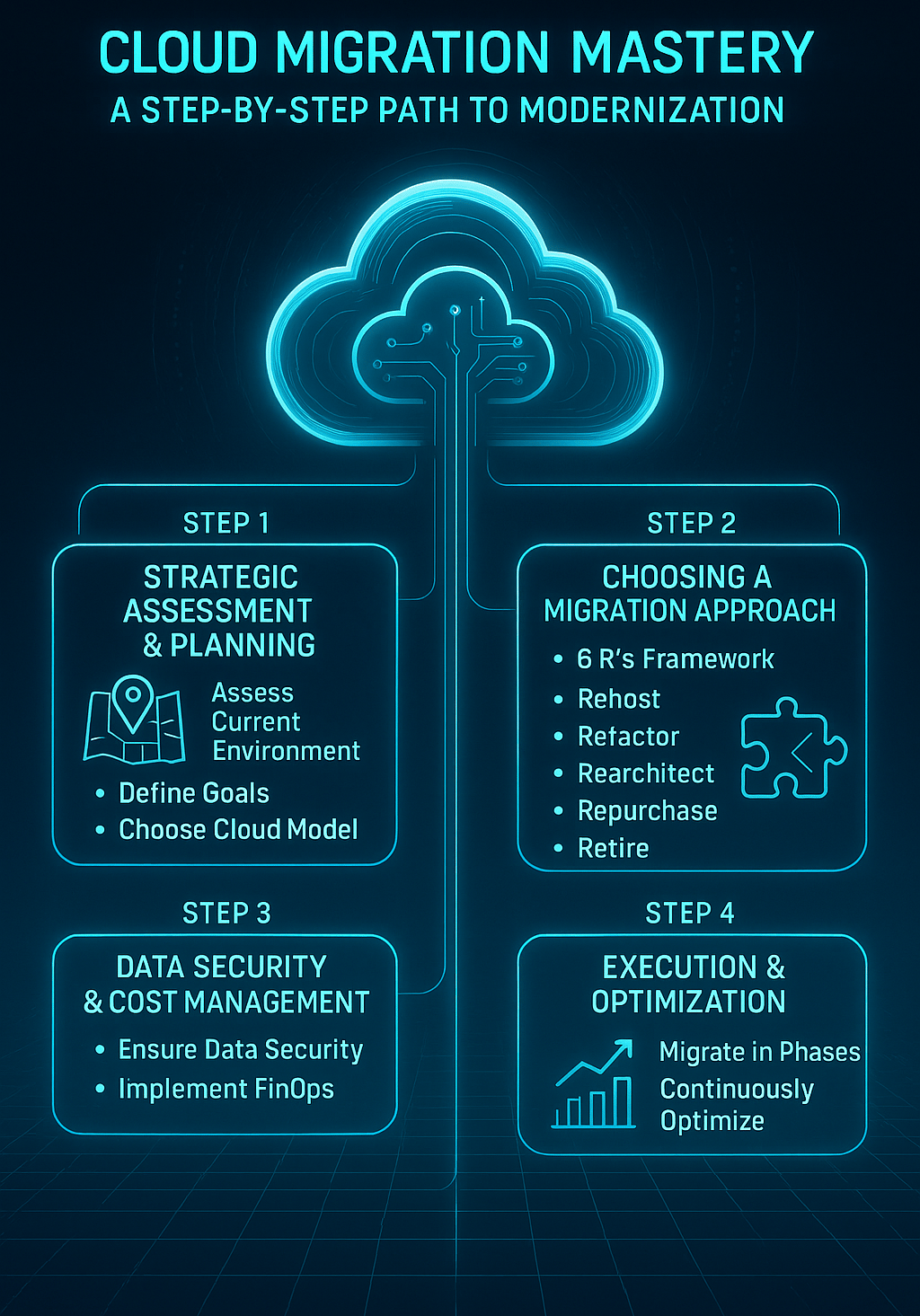Cloud Migration Mastery: A Step-by-Step Guide for Modernizing Your Business
Mr.Diyan Ahmed
10/3/20253 min read


SEO Idea: A comprehensive guide for business leaders on how to successfully plan and execute a cloud migration. The post will demystify the process, from strategic planning to execution, and highlight the key benefits and potential challenges.
SEO Keywords: cloud migration strategy, digital transformation, cloud computing benefits, SaaS adoption, data security cloud, hybrid cloud solutions, cloud migration guide, IT modernization, cloud cost management, scalability, flexibility.
Cloud migration is no longer an option—it's a fundamental step in the modern digital transformation journey. For business leaders, the move to the cloud promises immense cloud computing benefits like increased scalability, flexibility, and efficiency. However, without a solid plan, the process can seem daunting. This guide breaks down the journey to the cloud into manageable, strategic steps to help you modernize your business with confidence.
Step 1: The Strategic Assessment and Planning Phase 🗺️
Before you move anything, you need a clear cloud migration strategy. This initial phase is critical for success.
Assess Your Current Environment: Conduct a thorough audit of your existing IT infrastructure. Identify which applications and data are suitable for migration and which should remain on-premise.
Define Your Goals: What do you hope to achieve with this migration? Is it to reduce costs, improve performance, or enable remote work? Clearly defined goals will guide your decisions.
Choose the Right Cloud Model: Decide whether a public, private, or hybrid cloud solution is the best fit for your business needs. A hybrid approach, for example, allows you to keep sensitive data on-premise while leveraging the cloud for other operations.
Step 2: Selecting a Migration Approach
There isn't a one-size-fits-all approach to cloud migration. You need to choose the method that aligns with your business goals and technical requirements. The "6 R's" of cloud migration are a useful framework:
Rehost: Also known as "lift and shift," this is the simplest method. You move applications as they are from your data center to the cloud with minimal changes. It's fast but might not fully leverage cloud-native features.
Refactor: Rework the application's architecture to be more cloud-native. This requires more effort but can lead to better performance and scalability.
Rearchitect: Completely rebuild the application from the ground up to fully utilize cloud services. This is the most complex but also the most rewarding for long-term benefits.
Repurchase: Switch to a new software-as-a-service (SaaS) platform. This is a common SaaS adoption strategy for applications like CRM or ERP systems.
Retire: Decommission applications that are no longer needed. Don't migrate what you don't use.
Retain: Keep certain applications or data on-premise, often due to security regulations or critical dependencies. This is a key part of the hybrid cloud solutions model.
Step 3: Addressing Key Concerns: Data Security and Cost Management 🔐
Migrating to the cloud isn't just about technology; it's about managing business risks. Two of the biggest concerns are data security cloud and cost.
Data Security: While cloud providers offer robust security, it's a shared responsibility. Ensure you have clear policies for data encryption, access control, and compliance. Vet your chosen provider's security credentials and certifications.
Cost Management: Cloud costs can escalate if not managed proactively. Utilize tools for monitoring and optimizing resource usage. Implement a FinOps (Cloud Financial Operations) strategy to align your IT and finance teams. This ensures you only pay for what you use and can forecast future spending accurately.
Step 4: Execution and Optimization
With your plan in place, it’s time to execute the migration. Start with a pilot project to test your strategy before migrating critical applications. Once migrated, the journey isn't over. Continuous optimization is key to maximizing your cloud computing benefits. Monitor application performance, review costs regularly, and take advantage of new cloud services as they become available.
Conclusion: A Modern Business, Ready for the Future
Mastering cloud migration strategy is a journey that transforms your business. It allows you to shed the limitations of traditional IT and embrace the agility, scalability, and innovation that the cloud provides. By following these steps—from strategic planning to addressing security and cost—you can ensure a smooth migration that positions your business for long-term success in the digital era.
Connect
Partnering for innovation across industries.
Explore
Discover
+923001534092
© 2025. All rights reserved.
